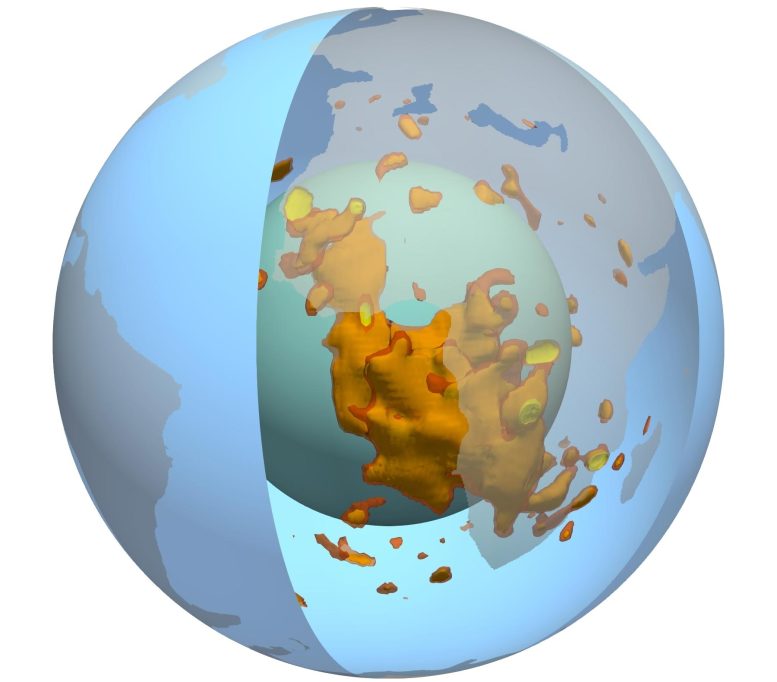
Una vista en 3D de la mancha en el manto de la Tierra debajo de África, que se muestra en colores rojo, amarillo y naranja. El color cian representa el límite entre el núcleo y el manto, el azul indica la superficie y el gris transparente indica los continentes. Crédito: Mingming Li / ASU
La tierra tiene capas como una cebolla, con una corteza externa delgada, un manto viscoso grueso, un núcleo externo fluido y un núcleo interno sólido. Dentro del manto, hay dos enormes estructuras parecidas a manchas, aproximadamente en lados opuestos del planeta. Las manchas, más formalmente denominadas Provincias Grandes de Baja Velocidad de Corte (LLSVP), tienen el tamaño de un continente y son 100 veces más altas que el Monte Everest. Uno está bajo el continente africano mientras que el otro está bajo el Océano Pacífico.
Usando instrumentos que miden las ondas sísmicas, los científicos saben que estas dos manchas tienen formas y estructuras complicadas, pero a pesar de sus características prominentes, se sabe poco sobre por qué existen las manchas o qué llevó a sus formas extrañas.
Los científicos de la Universidad Estatal de Arizona, Qian Yuan y Mingming Li, de la Escuela de Exploración de la Tierra y el Espacio, decidieron aprender más sobre estas dos manchas utilizando modelos geodinámicos y análisis de estudios sísmicos publicados. A través de su investigación, pudieron determinar las alturas máximas que alcanzan las manchas y cómo el volumen y la densidad de la mancha, así como la viscosidad circundante en el manto, podrían controlar su altura. Su investigación fue publicada recientemente en DOI: 10.1038/s41561-022-00908-3
También te puede interesar
-
Dormir bien el fin de semana puede reducir en una quinta parte el riesgo de sufrir enfermedades cardíacas: estudio | Cardiopatía
-
Una nueva investigación sobre la falla megathrust indica que el próximo gran terremoto puede ser inminente
-
Caso de Mpox reportado en la cárcel del condado de Las Vegas
-
SpaceX lanzará 21 satélites Starlink en el cohete Falcon 9 desde Cabo Cañaveral – Spaceflight Now
-
SpaceX restablece el lanzamiento pospuesto de Polaris Dawn, una misión espacial comercial récord
